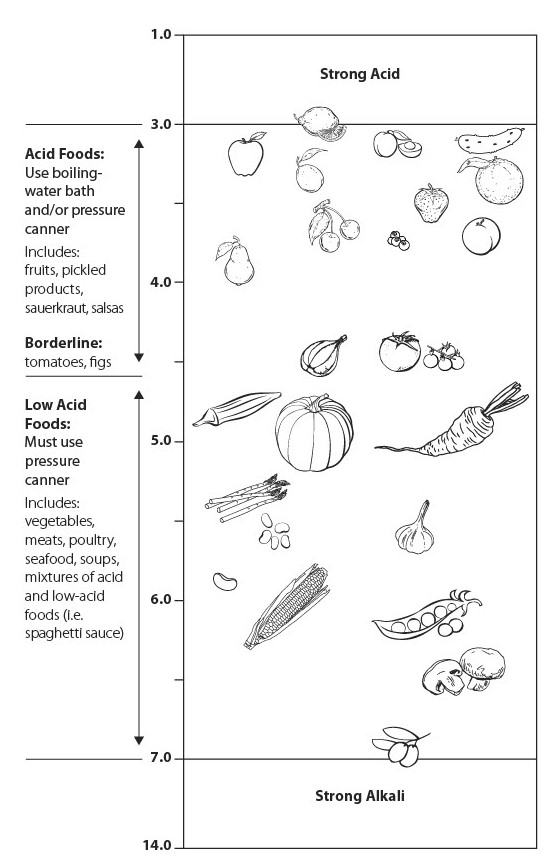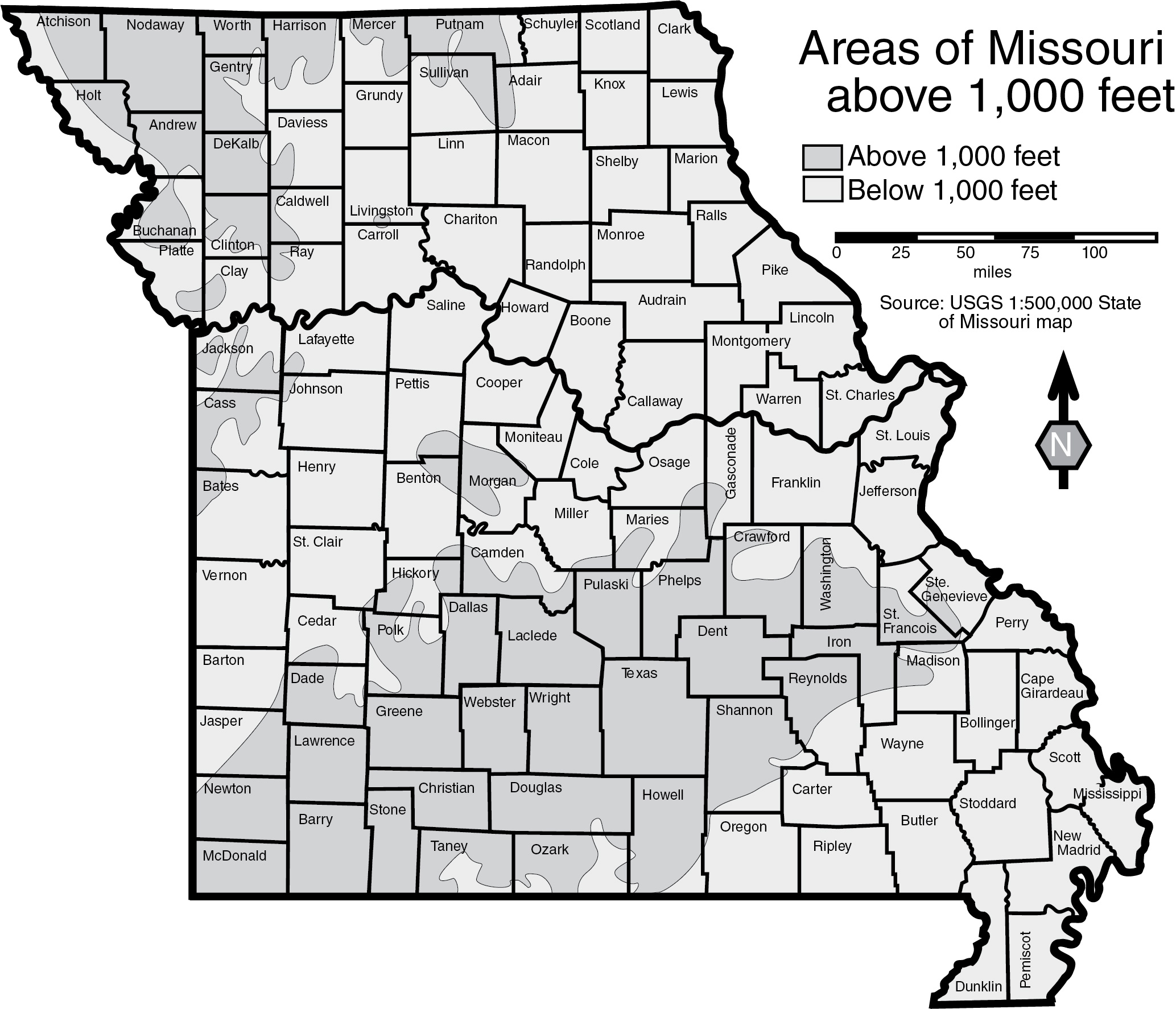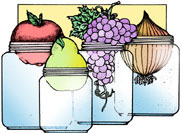Canning is an important, safe method of food preservation, if research-based recommendations are followed carefully. This guide provides an overview of the canning process, product acidity, and safety basics for preventing food-bourne illness. The recommended methods, equipment, and temperatures in this publication are based on the most current scientific research. Research has shown that some canning methods and equipment used in the past are no longer considered safe, so it is important that you read this guide carefully.
How canning preserves foods
Fresh foods spoil for a variety of reasons. Bacteria, molds and yeasts cause damage, as do food enzymes and contact with the air. Microorganisms live and multiply quickly on the surfaces of fresh food and inside bruised, insect-damaged and diseased food. Proper canning techniques will stop the growth and activity of microorganisms, therefore preventing spoilage and quality loss. Such spoilage poses a high risk of food-borne illness.
The canning process involves placing foods in jars and heating the product to a temperature that inactivates enzymes and destroys microorganisms that can cause the food to spoil. Air is driven from the jar during the heating process and as it cools, a vacuum seal is formed between the lid and the jar that prevents air from getting back into product and possibly re-contaminating the food.
Getting the best results
Use these techniques to get safe food and high-quality results:
- Select and wash quality fresh food, free from bruising, insect damage and disease.
- Food processed follows current recommendations from Cooperative Extension or USDA’s National Center for Home Food Preservation.
- Dial gauge pressure canners has been checked annually for accuracy (Most local MU Extension centers can check dial gauge pressure canners for accuracy at no or minimal cost. Weighted gauge pressure canners do not become uncalibrated, so there is no need for annual check for accuracy).
- Low-acid foods are processed in a pressure canner.
- High acid or acidified food processed in a boiling water or steam canner.
- Processing time and pressure adjusted for elevation.
- Processing time and pressure matches the size of jar, style of pack and type of food being canned.
- Use recommended jars and self-sealing, two-piece lids.
Unresearched recipes create a high food safety risk. Only use research-tested recipes dated 2009 or later from Cooperative Extension, the U.S. Department of Agriculture (USDA) or the National Center for Home Food Preservation (NCFHP).
Safety basics
There are three safe methods of home canning: boiling water, steam, and pressure. The recommended method depends on the acidity level of the food being canned. Before preserving by canning, you must determine if the food is high-acid or low-acid.
Highly acidic foods such as fruits, tomatoes, salsa, pickles and sweet spreads, should be canned using either the boiling water canner or the steam canner method.
Low-acid foods, such as vegetables, meats, poultry and fish MUST be canned using a pressure canner.
To prevent food-borne illness when canning high acid and low acid foods, you must carefully follow research-based methods and recipes.
Directions for safely using boiling water canners, steam canners and pressure canners (not pressure cookers) are provide in the MU Extension Guide GH1542, Steps for Successful Home Canning.
Preventing botulism
Clostridium botulinum, a common soil bacterium that causes botulism food poisoning, is destroyed in low-acid foods when they are processed at the correct time and temperature in pressure canners. Never use a boiling water or steam canner for low-acid foods because botulinum bacteria can survive this process. If Clostridium botulinum bacteria survive and grow inside a sealed jar of food, they can produce a deadly toxin. Even a taste of food containing this toxin can be fatal. Improperly canned low-acid foods may contain the toxin that causes botulism without showing signs of spoilage. Low acid and tomato foods not canned according to USDA-endorsed recommendations present the highest risk of botulism.
Product acidity affects processing methods
 Adapted from: USDA https://nchfp.uga.edu/publications/usda/GUIDE01_HomeCan_rev0715.pdf
Adapted from: USDA https://nchfp.uga.edu/publications/usda/GUIDE01_HomeCan_rev0715.pdf
Whether you should process food in a pressure, boiling water or steam canner to control botulinum bacteria depends on the amount of acid in the food. The term “pH” is a measurement of the acid level in a food. pH is measured on a scale from 1 to 14. The closer the pH value is to 1, the more acid the food contains. A pH of 7 is neutral.
Boiling water or steam canning is used for canning acidic foods (those with a pH under 4.6). Acidic foods, such as fruits, tomatoes and tomato products and pickled products, can contain enough acidity to either stop the growth of botulinum bacteria or destroy the bacteria more rapidly when heated. Pressure canning may also be used to process acidic foods, but the high heat and length of processing time can produce an overcooked product that lacks attractive color.
Low-acid foods do not contain enough acid to prevent the growth of the bacteria that cause botulism poisoning. Foods are considered to be low-acid if they have a pH level between 4.6 and 14. This category includes vegetables, meats, poultry, seafood, soups and mixtures of both acid and low-acid ingredients (e.g., tomato-based (acidic) spaghetti sauce with onions and green peppers (low acid). Process low-acid foods at temperatures of 240–250° F. To reach these high temperatures, you must use a pressure canner operated at 10 to 15 pounds per square inch (psi) of pressure. The exact processing time depends on the type of food being canned, whether the food was raw or hot packed, and the size of the jar. It is crucial to use a research-based recipe from a reputable source for the type of food product you wish to can. Contact your local MU Extension center for more assistance if needed.
Adjust for altitude to ensure safety

Figure 1. A map depicting the altitudes in Missouri relative to 1,000 feet above sea level.
It is important that you know your elevation — even in Missouri. Water boils at a lower temperature as elevation increases. If you live at an elevation above 1,000 feet (Figure 1), either you must increase the process time or canner pressure to make up for lower boiling temperatures. Lower boiling temperatures are less effective for killing bacteria. All research-based recipe guidance shares time and pressure adjustments for higher elevations.
Handling suspected spoilage
Foods are considered improperly canned if any of the following are true:
- Low-acid foods were not processed in a pressure canner.
- The dial gauge of the pressure canner was inaccurate when canning low-acid foods.
- The processing times and pressures used for the size of the jar, style of pack and kind of food were not in line with the most up-to-date recommendations.
- Ingredients were added that were not in a research-based recipe from a reputable source.
- Proportions of ingredients were changed from a research-based recipe from a reputable source.
- The processing time and pressure were not correct for the elevation at which the food was canned.
Look for any streaks of dried food on the outside of the jar. As you look at the contents inside the jar, see if you can detect cloudy canning liquid, rising air bubbles, or any unnatural colors. When you open the jar, make sure you do not see any mold growing. Also, pay attention to any spurting liquid or odd smells. These signs are strong indicators of food spoilage.
Never taste the food from a jar that you suspect has been spoiled. Instead, examine the jar carefully by at least one of the methods described above.
If you determine - or even suspect - spoilage is present, immediately dispose of the jar. Spoiled canned foods should be discarded in a place where they will not be eaten by humans or pets.
If the suspect canning jars are still sealed, place them in a heavy garbage bag. Close the bag and place it in a trash container or dispose of it in a nearby landfill.
For more information on detoxifying spoiled food, see the National Center for Home Food Preservation guidance.
Unsafe canning equipment and methods
Propane gas burner on an outside grill or a portable camp stove – These appliances are not recommended for canning because any wind or breeze tends to increase the amount of time needed to bring the water to a boil or maintain a boil in the pressure canner, therefore the pounds per square inch of pressure can drop easily, which disrupts consistent time processing. A drop in water temperature will also interfere with boiling water or steam canning. Some camp stoves have metal baffles on the sides so a canner cannot center over the flame.
Pressure cookers – Pressure cookers are designed to reduce meal cooking time. Do not confuse these kitchen tools with standard pressure canners. Pressure cookers have less metal, are smaller in diameter and use less water than pressure canners. The result is that the heat-up and cool-down times for the pressure canning process is much less than for the standard pressure canner. The heat-up and cool-down times are part of the total processing time that was used to establish a reasonable margin of safety. Before using a pressure cooker to home can in, makes sure that the cooker is large enough to hold a mininum of four quart jars. USDA research indicates that an appliance must have the structural design to hold no less than four quart jars in order for safe processing to occur.
NOTE: Pressure cooking in a pressure canner is not recommended. Pressure cooking in a pressure canner may leave food residue in the lid vents, causing issues when the pressure canner is later used for its intended purpose. A pressure canner CAN BE used to cook in as long as the lid is not attached (i.e. chili, spaghetti sauce, deep frying, etc.)
Electric pressure cooker/canner – This appliance DOES NOT meet the appliance standards for home pressure canning, even if it is marketed as safe for pressure canning. According to USDA, electric cooker/canners and instant pots do not have the volume necessary to process low-acid foods. The heat-up and cool-down time would be much less in a smaller appliance (than a traditional pressure canner), making the entire processing time in this appliance LESS than is needed for low-acid home canning processing times.
Solar canning – Heat generated by captured sunlight does not reliably process foods, and should never be used to home can low-acid or acid foods.
Oven canning – Oven canning is extremely hazardous. In oven canning, product temperatures never exceed the boiling point; this is not a safe method for either acidic, acidified or low-acid foods. Because this process fails to destroy the spores of Clostridium botulinum, it can cause the food to become toxic during storage. In addition, canning jars are not designed for intense dry heat and may explode, resulting in serious cuts or burns.
Microwave canning – Microwave ovens should not be used for home canning. Microwaved food may reach 212° F, but heating is not uniform throughout the product. Low-acid products (e.g., meats, vegetables) require consistent internal temperatures much higher than 212° F. There also is a danger that jars may explode within the microwave oven or as the food is being removed from the unit, resulting in serious cuts or burns.
Dishwasher canning – Processing home-canned foods in a dishwasher cycle is dangerous. The temperature of the water during the cleaning and rinsing cycle is far below that which is required to kill harmful microorganisms. A product heat processed in a dishwasher will be unsafe to eat.
NOTE: It is safe to use the dishwasher to clean and sterilize empty jars for the home canning process, if the dishwasher has a “sterilize” setting.
Open-kettle canning (Inversion) method – This method of processing food involves filling and sealing hot packed food and liquid in canning jars, inverting the jars onto their lids, with no further heat treatment or processing. The process is not recommended for any type of home canning, because the amount of heat it applies is insufficient to destroy bacteria. The final product may spoil quickly or cause illness when consumed.
Dry Canning – This method calls for putting dried foods, such as grains, beans or nuts, into canning jars. Lids may or may not be applied to the jars before they are heated in a 200° F oven. There are several concerns with this method with the main risk being that you can’t determine whether bacterial spores or mold spores have been destroyed, even though the jar lid may seal. Dry canning also does not remove all of the oxygen from the jar and could trap moisture from condensation resulting in spoilage.
Jars with wire bails and glass caps – These make attractive storage containers for dry foods, but are not safe for home canning. One-piece zinc, porcelain-lined caps are also no longer recommended.
References
- Andress, E.L., and J. A. Harrison. 2014. So easy to preserve, 6th ed. Bulletin 989. Athens, GA: University of Georgia Cooperative Extension Service.
- This material was adapted from the Complete Guide to Home Canning, United States Department of Agriculture, Agriculture Information Bulletin No. 539.
This material was adapted from the Complete Guide to Home Canning, United States Department of Agriculture, Agriculture Information Bulletin No. 539.
 Developed by Barbara Willenberg
Developed by Barbara Willenberg